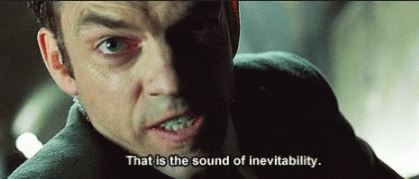Overall this album has felt like pretty slow going so far. I’ve been gaming, reading, napping, and occasionally firing up the music rig. A little slower is okay; there’s still momentum. Especially when I consider that I did record two more pieces for Ambient Online during this period. Honestly, I think it feels like more time has passed than actually has.
If the momentum does stop, or I feel unhappy with the quality of my work, I’ll pull the alarm and go back to a song-a-week-or-more format until I reboot myself. Hopefully that won’t be necessary.
Anyway, a month ago I thought I had a theme for this — waveshaping and nonlinearity — but I things haven’t really solidified that way. Instead, they have picked up the less technical, more emotional and esoteric themes of incubation and hesychia from the Kingsley book. It’s a more appealing choice, but it’s honestly not too far off from where my music tends to go anyway, so it feels a bit like no theme at all.
Speaking of books, what I’m into right now is K. J. Parker’s Sharps. In a setting similar to Renaissance Europe, a small, poor kingdom decides the path to maintaining a fragile peace with a neighbor is sending a national fencing team for Olympics-style diplomacy. Everything goes wrong due to some coincidence of bureaucratic incompetence, basic human laziness, corruption, and colliding conspiracies, and it’s often hard to tell which is which. Much like the news in 2019, only a lot more fun.
The book makes me want to learn some things about fencing. What the heck is a demi-volte? What just happened in that big action scene? Why was the thing that somebody just said significant? I’m missing some of the story here I think.
I’m still on Guild Wars 2. I’ve gotten to level 80 with 4 characters:
- A sylvari Mesmer, who went through the Path of Fire story and converted to the Mirage spec, which I’m not really certain is either more effective or more fun. (It’s not like converting back is hard now though.)
- A human Necromancer, who I kept at the core spec because Death Shroud — which looks and feels a lot like the wraith world of the Nazgul in the LOTR movies — just seems a lot cooler than summoning sand shades. This is probably my most capable character in a solo situation.
- A sylvari Engineer, who converted to the lightsaber-ish Holosmith spec, and who looks extremely cool. But I had serious trouble in Southsun Cove (due to “quiet” Confusion applied by some of the monsters there which causes you to injure yourself) and found the intro to the Path of Fire area much more difficult than with the Mesmer.
- A Norn Ranger, who went for the Soulbeast spec. It’s kind of cool to take on some of the aspects of various animals, but the special effects are lackluster and the actual effectiveness is questionable.
I also started a couple of thieves and an elementalist who got a little ways in and I just found they weren’t as fun or effective to play — though that could just mean I need to adopt to a different spec and playstyle. I’m now on a sylvari Guardian, who feels fun and flashy, intending to go for the Firebrand spec.
I haven’t visited all the level 80 zones, though I think between all my characters combined, I’ve covered all the below-80 zones. I figure once I max out this Guardian, I’ll pick a character and try to get 100% map completion. After that I might chase after achievement titles, unlocking more cosmetic gear, and maybe even try WvW, which I’ve never done before, or solo Fractal Dungeons. There’s a ton of content in this game and as much of it as I’ve seen, there’s a lot more — not like when I had 70+ characters in Champions Online and had done basically everything except the premium mission content.
There’s also Stranger Things. We just watched Season 3, and then rewatched Season 1 (which I’d only sort of half-watched and missed a few key things). It’s far from a perfect show, and some of its appeal is in intentional 80s cheese (turned up to 11, so to speak, for the third season). But it’s a pretty fertile setting for more stories — who knows what else might come from the Upside-Down, whether there are other otherworlds, what else went on in that lab or elsewhere in US and Russian psychic research, whether there are any other psychics besides Eleven and Eight (maybe Will’s developing something?)
Of course in my circles, a big part of Stranger Things is the synth soundtrack. It’s kind of become the Stairway to Heaven of synth players, and Season 3 brought with it a whole new wave of covers. I like the music, but please, people, create something new. Or do a creative rather than an imitative cover of anything else. Or go ahead and do your imitation, for your own amusement and learning purposes, and then don’t post it anywhere. Ask yourself whether the world will be a better place because there is one more cover of the Stranger Things theme.
(I had thought Season 3 was a lot heavier on the licensed 80s music than previous, but Season 1 did have quite a few — including sneaking in Tangerine Dream’s “Kiew Mission”, itself an 80s all-synth track that slides right in alongside the score.)
As I have recently posted elsewhere, I like it when artists take iconic 80s style synth sounds — or at least, the “synthwave” sounds we identify as 80s sounds now, though they’re not entirely representative — and then do something fresh and new with them rather than going pure retro. I feel like SURVIVE, Makeup & Vanity Set, and some others do that pretty well.


